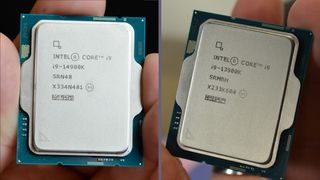Intel has come ahead with a commentary at the crashing problems with its high-end 14th-gen and Thirteenth-gen CPUs, in any case clarifying the reason – or a minimum of the foremost issue, it seems that – and telling affected processor homeowners {that a} microcode repair is coming.
Staff Blue informs us that ‘increased running voltage’ is the reason for instability issues of those processors – most commonly Core i9s consistent with experiences, which might be the chips that guzzle essentially the most energy, in fact – in line with an in depth research of the CPUs which have been despatched again to Intel because of this flaw.
In any other commentary (that we’ll come again to later), Intel additionally tell us that those increased voltages are a ‘key component’ of the instability factor – so it appears like they’re the primary reason (if now not the one one, and once more – we’ll go back to speak about this in a while).
As for Intel’s commentary, it reads: “Our research of returned processors confirms that the increased running voltage is stemming from a microcode set of rules leading to wrong voltage requests to the processor.
“Intel is turning in a microcode patch which addresses the basis reason for publicity to increased voltages. We’re proceeding validation to make certain that eventualities of instability reported to Intel relating to its Core Thirteenth/14th-gen desktop processors are addressed. Intel is lately focused on mid-August for patch unlock to companions following complete validation.”
Staff Blue provides that it’s “dedicated to creating this proper with our shoppers” and that those that are experiencing instability with a 14th-gen and Thirteenth-gen chips must touch Intel buyer improve for help.
Intel is lately validating the microcode patch, with supply due in the course of August as discussed, not up to a month from now.

Research: Oxidation specter is a separate factor
As you can be conscious, Intel has prior to now issued a microcode replace to song its Enhanced Thermal Speed Spice up (TVB) characteristic – the place the CPU is driven to a sooner most spice up briefly, whilst temperatures permit for this pace – which used to be partially accountable for those instability woes, we had been instructed on the time.
So, a 2nd patch is vital to regulate the chip’s voltage going too excessive, on best of that spice up factor. With a bit of luck, this may see the answer of PC video games crashing with those Core i9 processors (and different lower-tier chips, in accordance to a couple experiences – despite the fact that this appears to be so much much less commonplace).
Having a look at replies to that Intel commentary on its product improve boards, and feedback in different places on-line, now not everyone seems to be satisfied that that is going to be the panacea to mend a majority of these instability gremlins. People also are nervous about discussions in different places about conceivable problems with oxidation and degradation of affected CPUs, which a rep from Staff Blue addressed on Intel’s subreddit (as VideoCardz spotted).
Intel stated this oxidation downside, however stated it used to be a separate factor associated with production previously, and best relates to previous Thirteenth-gen CPUs (it used to be addressed ultimate yr, actually).
That is the complete commentary supplied through Intel on Reddit: “We will be able to ascertain that the by way of oxidation production factor affected some early Intel Core Thirteenth-gen desktop processors. Then again, the problem used to be root led to and addressed with production enhancements and monitors in 2023.
“We now have additionally checked out it from the instability experiences on Intel Core Thirteenth-gen desktop processors and the research to-date has made up our minds that just a small selection of instability experiences can also be hooked up to the producing factor.”
In brief, it is a separate and quite unusual factor. It’s right here that Intel additionally mentions that: “For the instability factor, we’re turning in a microcode patch which addresses publicity to increased voltages which is a key component of the instability factor.”
Does the truth that increased voltages are framed as a ‘key component’ counsel there are different parts for the investigation to pin down, nonetheless? Or does that refer to these different parts being the former TVB patch, in addition to motherboard settings and the opposite nuances which have been discussed previously?
We are hoping it’s the latter, and general, this entire affair has been an unlucky nest of system faults and interrelated issues. With a bit of luck, Intel’s newest transfer and incoming patch will necessarily nail the repair for just right – when blended with the opposite aforementioned answers. So, make sure to set up this microcode replace when it arrives subsequent month (by way of a BIOS replace out of your motherboard maker).
The remainder fear for some might be centered at the previous chatter about conceivable degradation problems – the stableness of CPUs reportedly getting worse over the years – and whether or not this may have some roughly an have an effect on at the longevity of affected processors over the longer-term.
Which means will your Core i9 now best have legs for, say, six or seven years, reasonably than many extra, because of having been run in those volatile stipulations for doubtlessly many months? The difficulty being that whilst you get into the weeds to this extent, neatly, it’s very tricky to grasp anything else needless to say – however we bet time, and if there are spiking chip failure charges, will inform sooner or later, if there are this sort of problems for some other people.

Allow 48h for review and removal.